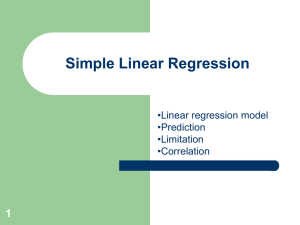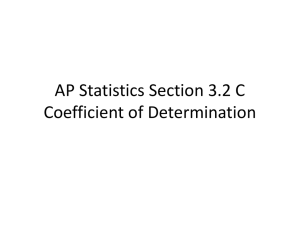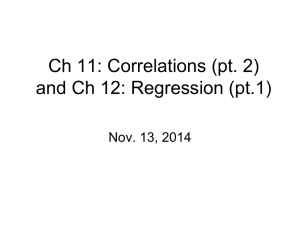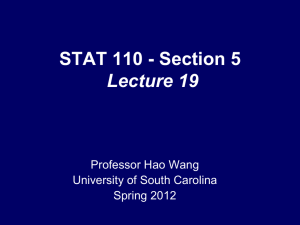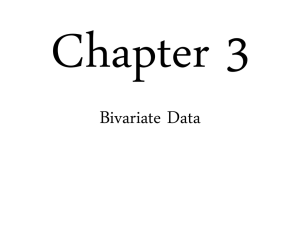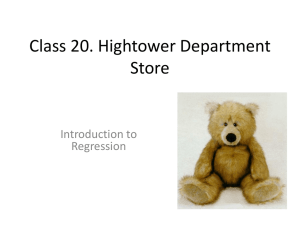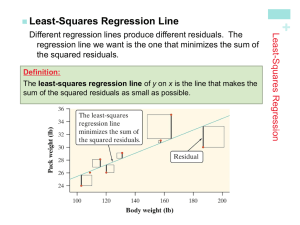Regression analysis
advertisement
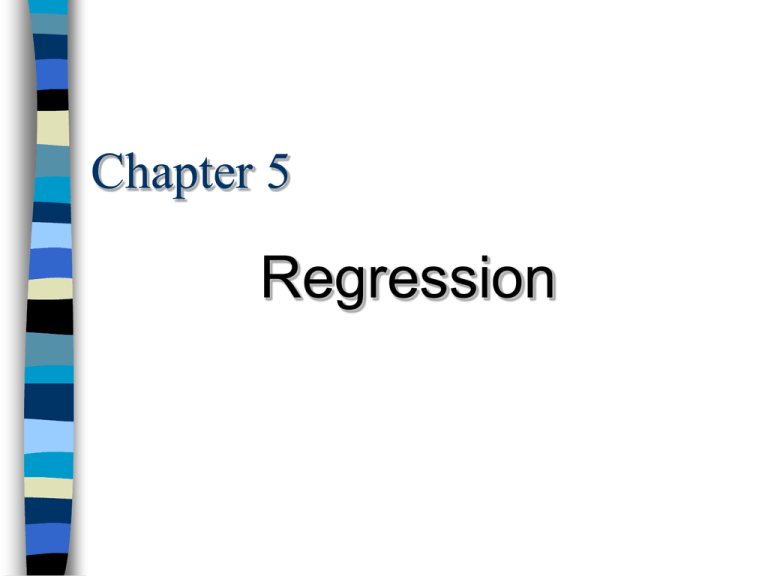
Chapter 5 Regression Chapter outline The least-squares regression line Facts about least-squares regression Residuals Influential observations Cautions about correlation and regression Association does not imply causation Correlation and Regression Regression effects are depicted by the slope of the line. Correlation can be seen as the spread of points around the regression line. The greater the amount of spread of points around the regression line, the less predictive is X of Y and consequently, the weaker the correlation. Perfect Positive Correlation 25 20 15 10 5 0 0 5 10 15 Correlation r = 1 20 25 Potato Chip Consumption No Correlation 12 10 8 6 4 2 0 0 20 40 60 80 Feeling Thermometer for Clinton 100 120 Imperfect Correlation and Relationships We rarely see perfect correlation While Correlation is never perfect, we can draw a line to summarize the trend in the data points. This is the Regression Line Regression Line Regression Line: A straight line that describes how a response variable y changes as an explanatory variable x changes. It can sometimes be used to predict the value of y for a given value of x. Making Predictions Where do we Draw the Line? Age and Income 45 40 Income in $10,000 35 30 25 20 15 10 5 0 0 10 20 30 40 Age 50 60 70 80 Minimize the sum of the distances between the points and the line 12 10 -.25 +2 8 +2 6 -3.5 4 -.25 2 0 0 1 2 Square the Distances 3 4 5 6 7 The best fitting line would minimize the sum of the squared distance of every point in the scatterplot from the regression line n 2 ( yi yˆ i ) Minimize i 1 This line -- the best-fitting line -- is that line which -- compared to any other line you could plot through the points -produced the smallest sum of squared deviations. •The slope b is the change in y when x increases by 1. • The intercept a is the predicted value of y when x = 0. Finding the equation of the regression line Exercise 5.16 (Page 125) Facts about least-squares regression line Fact 1:It is a mathematical model for the data. Fact 2: The distinction between explanatory and response variables is essential in regression. Fact 3: There is a close connection between correlation and the slope of least squares line. Fact 4: The least-squares regression line always passes through the point ( x, y,) where x is the mean of the x values, and y is the mean of the y values. Fact 5: The correlation r describes the strength of a straight-line relationship. In the regression setting, this description takes a specific form: the square of the correlation, r2, is the fraction of the variation in the value of y that is explained by the least squares regression of y on x. Residual plots A residual plot is a scatterplot of the regression residuals against the explanatory variable. Residual plots help us assess the fit of a regression line. A residual is the difference between an observed of the response variable and the value predicted by the regression line. That is, Residual =observed y – predicted y = ˆ y y Outliers and Influential Observations An outlier is an observation that lies outside the overall pattern of the other observations An observation is influential for a statistical calculation if removing it would markedly change the result of the calculation. Points that are outliers in the x direction of a scatterplot are often influential for the least-squares regression line. Influential observations can also be described as outliers. Outliers and Influential Observations 350 Heart attacks 300 Outlier 250 200 150 Influential observation 100 50 0 0 2 4 6 8 10 Wine consumption 12 14 16 Beware extrapolation Extrapolation is the use of a regression line for prediction far outside the range of values of the explanatory variable x that you used to obtain the line. Such predictions are often not accurate. Example Suppose Angela was 1.20m tall on January 1st 1975, and 1.40m tall on January 1st 1976. By extrapolation, estimate her height on January 1st 1977. By extrapolation, it could be estimated that by January 1st 1977 she would have grown another 0.20m to be 1.60m tall. This however assumes that she continued to grow at the same rate. This must eventually become a false assumption, otherwise by January 1st 1980, she would be a giantess. Lurking variable A lurking variable is a variable that has an important effect on the relationship among the variable in a study but is not included among the variables studied. Example: Studies of relationship between treatment of heart disease and the patients’ gender show that women are in general treated less aggressively than men with similar symptoms. Women are less likely to undergo bypass operation. Question: Might this be discrimination? Answer: No. Be aware of the lurking variable: Although half of heart disease victim are women, they are on the average much older than male victim. Association does not imply causation Example: Sales of rum and number of Methodist ministers is positively correlated, but a large number of ministers does not encourage rum drinking. Is there a lurking variable that influences both rum sales and Methodist ministers? The the previous example, both the sales of rum and the number of Methodists ministers were correlated with the number of people in the U.S. As the number of people increases, it causes an increase in demand for both Methodist ministers and for rum.
